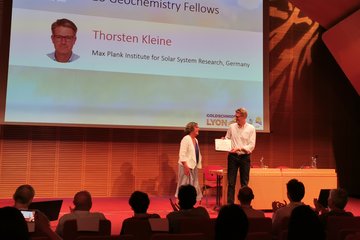Alle Typen
1.
Zeitschriftenartikel
Maximizing Dust Devil Follow-Up Observations on Mars Using Cubesats and On-Board Scheduling. Journal of the Astronautical Sciences 69, S. 918 - 940 (2022)
2.
Zeitschriftenartikel
Global Drivers and Transport Mechanisms of Lunar Rockfalls. Journal of Geophysical Research: Planets 126 (10), e2021JE006824 (2021)
3.
Zeitschriftenartikel
A Labeled Image Dataset for Deep Learning-Driven Rockfall Detection on the Moon and Mars. Frontiers in Remote Sensing 2, 640034 (2021)
4.
Zeitschriftenartikel
Analyzing multi–domain learning for enhanced rockfall mapping in known and unknown planetary domains. ISPRS Journal of Photogrammetry and Remote Sensing 182, S. 1 - 13 (2021)
5.
Zeitschriftenartikel
Peering into lunar permanently shadowed regions with deep learning. Nature Communications 12, 5607 (2021)
6.
Zeitschriftenartikel
Human-assisted Sample Return Mission at the Schrödinger Basin, Lunar Far Side, Using a New Geologic Map and Rover Traverses. The Planetary Science Journal 2 (2), 51 (2021)
7.
Zeitschriftenartikel
Impacts drive lunar rockfalls over billions of years. Nature Communications 11, 2862 (2020)
8.
Zeitschriftenartikel
Deep Learning-driven Detection and Mapping of Rockfalls on Mars. IEEE Journal of Selected Topics in Applied Earth Observations and Remote Sensing 13, S. 2831 - 2841 (2020)
9.
Zeitschriftenartikel
Lunar south pole boulders and boulder tracks: Implications for crew and rover traverses. Icarus 348, 113850 (2020)
10.
Zeitschriftenartikel
Unsupervised Learning for Thermophysical Analysis on the Lunar Surface. The Planetary Science Journal 1, 32 (2020)
11.
Zeitschriftenartikel
Present-day gully activity in Sisyphi Cavi, Mars – Flow-like features and block movements. Icarus 350, 113899 (2020)
12.
Zeitschriftenartikel
Using Boulder Tracks as a Tool to Understand the Bearing Capacity of Permanently Shadowed Regions of the Moon. Journal of Geophysical Research: Planets 125 (2), e2019JE006157 (2020)
13.
Zeitschriftenartikel
Analysis of Lunar Boulder Tracks: Implications for Trafficability of Pyroclastic Deposits. Journal of Geophysical Research: Planets 124 (5), S. 1296 - 1314 (2019)
14.
Zeitschriftenartikel
Automated Detection of Lunar Rockfalls Using a Convolutional Neural Network. IEEE Transactions on Geoscience and Remote Sensing 57 (6), S. 3501 - 3511 (2019)
15.
Zeitschriftenartikel
Quantitative Assessment of Digital Image Correlation Methods to Detect and Monitor Surface Displacements of Large Slope Instabilities. Remote Sensing 10 (6), 865 (2018)
16.
Konferenzbeitrag
Extreme Low-Light Environment-Driven Image Denoising Over Permanently Shadowed Lunar Regions With a Physical Noise Model. In: Proceedings of the IEEE/CVF Conference on Computer Vision and Pattern Recognition (CVPR), S. 6317 - 6327. (2021)
17.
Vortrag
Global Driversof Lunar Rockfall. 52nd Lunar and Planetary Science Conference , online (2021)
18.
Vortrag
NASA Frontier Development Lab: Lunar Resource Mapping - Data Fusion and AI-driven Anomaly Detection. Mining Space Summit 2019, Luxembourg, Luxembourg (2019)
19.
Vortrag
Lunar South Pole Boulders and Boulder Tracks: Implications for Crew and Rover Traverses. NASA Exploration Science Forum 2019, Mountain View, CA, USA (2019)
20.
Vortrag
The Stepped Frequency GPR: A Proposal to investigate the Lunar Subsurface. EGU General Assembly 2019, Vienna, Austria (2019)











